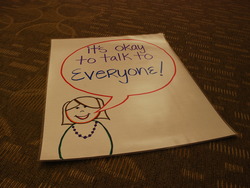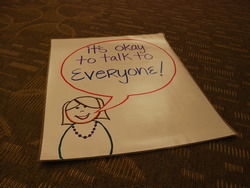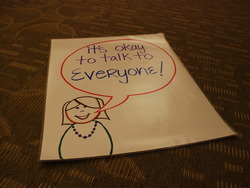


Betsy Allen
Reflecting on how you like to learn reveals insights into good and poor training. One of the qualities of a good learning environment is that it has to be emotionally safe. This means an environment that is free from intimidation and rejection, high in acceptable challenge, and where the learner experiences active participation and relaxed alertness. What solutions does new research offer for creating safe environments that increase retention?
The Science
Our brains are unable to pay attention to all the information that it receives from the senses, so it selects only the high contrast, personally meaningful information that has a link or an association with previous learning. If the information that is received by the brain is perceived to be threatening, either physically or psychologically, the cerebral logical thinking process closes down as the hypothalamus and pituitary gland team up to release adrenaline in a “fight or flight” response. This primeval automatic response is good for escaping danger but poor for learning.
When we reflect on some of our own bad learning experiences, we may recall feelings of anxiety, butterflies in the stomach and a pounding heart due to unfamiliar and unfriendly learning environments. These feelings translate to less learning and, as a trainer, we need to develop an empathetic understanding of the learner.
When the brain receives sensory information, the thalamus acts as a relay station and directs the information to the amygdala and the hippocampus. The amygdala, at the center of the emotional brain, checks the information for emotional content. If it perceives it to be a threat to self preservation, it closes down the connections to the executive section of the brain in the prefrontal cortex and logical thinking becomes impaired. Stress hormones are released, the muscles of the body receive an extra supply of blood, nutrients are released for a rapid conversion to glucose, giving added energy for the “fight or flight” response. The greater the stress, the greater the depletion of available nutrients for learning. This limits the connections between brain cells resulting in slow thinking and depressed learning.
Setting a positive emotional climate is essential for learning. We call it the social component of learning. When the appropriate emotional level is reached, learning is more meaningful, enjoyable and lasting. The appropriate emotional level is when the learner experiences a feeling of relaxed alertness. This means that they are fully engaged and motivated in a physically and psychologically comfortable learning environment. New learning is stored in the short term and working memory in the hippocampus and the prefrontal coitex. When setting the learning climate, special care must be taken to ensure a caring attitude, where every learner is respected and valued, each bringing to the learning experience unique talents.
The Solution
To get a relaxed alertness environment, start a training session with an opener which breaks preoccupation, allows networking and gets them talking. They may have argued with a significant other, been disappointed, experienced road rage or just plain anxious about the new training. When there is an emotional outlet—such as time to consider personal feelings and express them to others—learning is more likely to continue uninterrupted without lingering feelings of anger or frustration. Puzzles, challenges and intellectually stimulating introductions to your topic create this state of relaxed alertness.
Some puzzle ideas you can use as an opener include: crosswords, Sudoku, word wheel or a general knowledge or trivia game. SCORE and SCORE Two, written by co-training consultants Rich Meiss, Doug McCallum and Bob Pike, have many great, ready-to-use openers.
Betsy Allen is co-author of Powerful Presentations.
Don't miss out on updates and chances
to sharpen your skills with participant-centered learning.




3740 N Chestnut St #113 - Chaska, MN 55318-3053